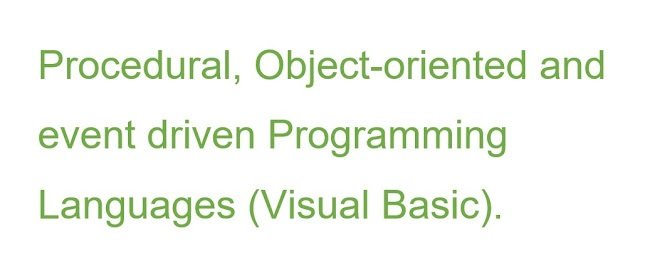Procedural, Object-oriented and event driven Programming Languages (Visual Basic).
Procedural Programming can be defined as a programming model which is derived from structured programming, based upon the concept of calling procedure. Procedures, also known as routines, subroutines or functions, simply consist of a series of computational steps to be carried out. During a program’s execution, any given procedure might be called at any point, including by other procedures or itself.
Languages used in Procedural Programming: FORTRAN, ALGOL, COBOL, BASIC, Pascal and C.
Procedural Programming Languages:
In procedural programming, program is divided into small parts called functions.
Procedural programming follows top down approach.
There is no access specifier in procedural programming.
Adding new data and function is not easy.
Procedural programming does not have any proper way for hiding data so it is less secure.
In procedural programming, overloading is not possible.
In procedural programming, function is more important than data.
Procedural programming is based on unreal world.
Examples: C, FORTRAN, Pascal, Basic etc.
Object Oriented Programming:
Object oriented programming can be defined as a programming model which is based upon the concept of objects. Objects contain data in the form of attributes and code in the form of methods. In object oriented programming, computer programs are designed using the concept of objects that interact with real world. Object oriented programming languages are various but the most popular ones are class-based, meaning that objects are instances of classes, which also determine their types.
Languages used in Object Oriented Programming: Java, C++, C#, Python, PHP, JavaScript.
Object Oriented Programming :
- In object oriented programming, program is divided into small parts called objects.
- Object oriented programming follows bottom up approach.
- Object oriented programming have access specifiers like private, public, protected etc.
- Adding new data and function is easy.
- Object oriented programming provides data hiding so it is more secure.
- Overloading is possible in object oriented programming.
- In object oriented programming, data is more important than function.
- Object oriented programming is based on real world.
- Examples: C++, Java, Python, C# etc.
- Event-driven Programming Languages:
Event-driven programming is when a program is designed to respond to user engagement in various forms. It is known as a programming paradigm in which the flow of program execution is determined by “events.” Events are any user interaction, such as a click or key press, in response to prompt from the system. To visualize event programming more clearly, imagine the opposite of event-programming is a software that requires zero user interaction.
Events are monitored by a code (or function) known as an event listener. If the event listener detects that an assigned event has occurred, it will trigger a callback function, known as an event handler, which will perform said event, e.g. clicking (the event) a “print” button (event listener) activates the actual print process (event हैंडलर)। Virtually all object-oriented and visual languages support event-driven programming. Visual Basic, Visual C++ and Java are examples of such languages. A visual programming IDE such as VB.Net provides much of the code for detecting events automatically when a new application is created.

